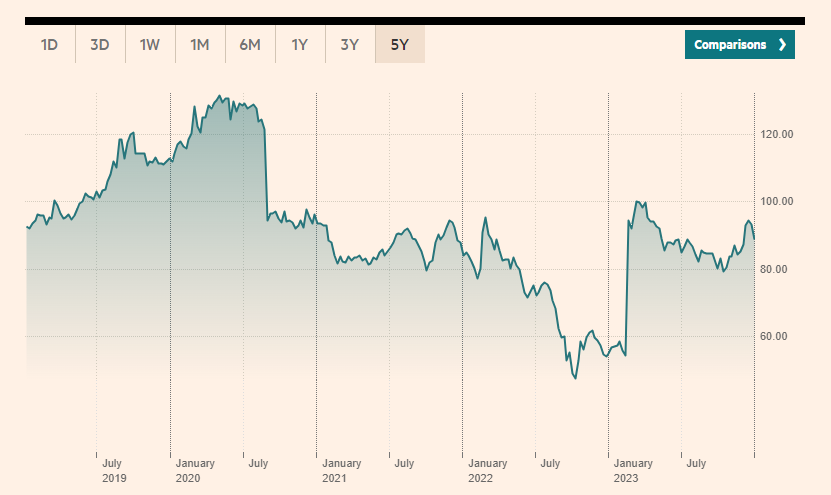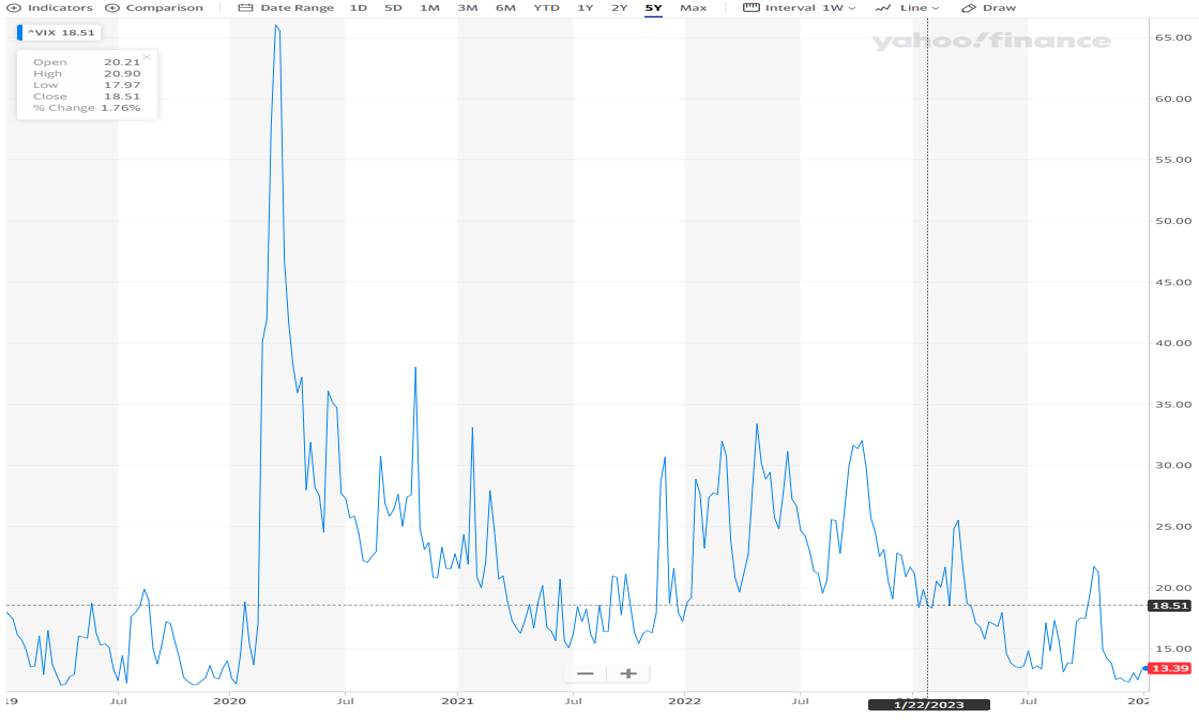LGB’s Market Commentary for Q4 2023
A Forecast Free Zone
This is the season of forecasts. A bit like midges in the Scottish Highlands, they come around every year, and are about as much use. At the beginning of 2023 these were the forecasts of five major investment firms for the S&P 500 at year end from a starting point of 3,839.5: Barclays 3,675; Morgan Stanley 3,900; UBS 3,900; Citi 3,900 and BlackRock 3,930. The outturn was 4,783 (+24%). And who now remembers the confident and widespread forecasts of Sterling breaking parity with the dollar in Autumn 2022? Certainly not Goldman Sachs who were forecasting 1.30 in December. Forecasting is inherently problematic. Clarity as to where we are now may be as much as we can hope for – and understanding what different classes of investments offer us now, and some of the risks attached, may therefore be useful.
Fixed Income
We can start with the sometimes mislabelled risk-free assets, government bonds. Here is the five-year price chart of the UK 30 year gilt:

(source: FT)
Ouch. With prices having fallen from high to low by well over a half, it is a reminder that lending to governments may mean you get your money back, but your holdings can be subject to massive swings in valuation along the way, particularly for bonds with longer duration.
At the time of writing the UK 10 year gilt are trading somewhere around the middle of their recent range, at a yield to maturity of 3.8%, having hit a high of 4.75% in the autumn, and a low of 3.5% around Christmas. This compares with one month sterling T-Bills yielding 5.15%. US ten year rates hit 5% in October, retreated to just over 3.75% around Christmas and are now at c. 4.05%. Four week US T-Bills yield 5.4%. German 10 Year bonds yield 2.185%, after reaching almost 3% in the autumn and just under 1.9% late last year, whereas short term Euro bills yield around 3.7%. All these markets, with so-called “inverted yield curves” are implying that rates will fall and indeed, inflation does seem to be falling – at least at consumer level (CPI annualised 0.6%, 2.7% in the eurozone and 1.9% for the equivalent US measure). Hence, on the face of it, lending to governments – disregarding of course their regrettable tendency to tax the interest they pay – would seem a reasonable way to safeguard money. And if rates do indeed come down there will be a capital gain as the prices rise.
In the UK, taxpayers can (given the large stock of bonds outstanding issued when rates were much lower) escape much of the tax on interest by buying low-coupon older bonds, government and corporate, which trade on a discount, using the “Qualifying Corporate Bond” exemption: the accretion of the bond to par at maturity is tax free and only the coupon is taxed.
Please note that investors with accounts on the LGB Investments platform have access to UK T-Bills, Gilts and a corporate bond list with suggestions of bonds trading at a discount to par.
However, low CPI, helped down by energy prices in the latter part of 2023, is not the whole story. Central banks (outside the Eurozone) have to worry about the tightness of the labour market, and the danger that inflationary expectations are now baked in. They have seen inflation fall without the recessions they had anticipated but having by common consent waited too long to raise rates, they may well overshoot on the downside. Continued disruption to energy exports, whether from the Gulf via the Red Sea or due to the Ukraine conflict, could reverse the trend. The assumption that current rates are abnormally high is only true if your definition of normality starts with the Global Financial Crisis. But if you believe the inflationary pressures have been vanquished then Gilts and investment grade corporate bonds will offer a reasonable if unexciting return. If normality is indeed a sub 2% rate then longer dated bonds will offer substantial capital gains too. If central banks fail to get inflation down then sub-4% longer term rates do not make much sense.
Investors looking for safe short-term homes for their cash could consider the weekly UK T-Bill auctions. At last week’s auction the 6-month yields were quoted 5.17%-5.21%. Contact us for guidance on how to participate.
There is no consistent way of tracking Sterling sub-investment grade bonds. The US High Yield Bond Index has recovered sharply in the last few months as fears of recession have fallen away and is at an all-time high. Quoted UK high-yield paper has also recovered somewhat (e.g. the Bruntwood 6% 2025 which is trading at 96.5 vs 92.5 in October).
Yields on LGB’s MTN issues have not yet started to fall back and can offer a decent real return in this environment. For example, Lendco Limited, a solid specialist property lender with an outstanding track record and significant private equity backing, is currently offering 11% p.a. for new 2 year notes.
Forecasts for the property market, following some extreme pessimism earlier this year, are now starting to rise (e.g from Pantheon Macroeconomics), and the market continues to be resilient on the back of a 4 million home deficit in the UK, vs. 60,000 build-to-let units in process and total housing unit construction not much over 200,000 per year.
Equities
The US equity market is notoriously dominated by the “Magnificent Seven” tech stocks, which had doubled to mid-December 2023, pulling the rest of the market up (the NASDAQ 100 was up 52% last year, the S&P 24%) – though outside of the seven it was down for the first three quarters of 2023. European markets are the opposite. The UK underperformance (up 1.6% last year) has led to a degree of existential angst but to a large extent reflects the heavy weighting of miners, oil stocks and financials. A recovery of China and a Shell bid for BP (frequently rumoured) would change the statistics somewhat. Smaller stocks have languished and AIM itself has been woeful- it is not yet clear whether the Mansion House reforms will redirect any meaningful amount of pension money into the market, which badly needs some institutional support: small cap and AIM-specialist funds have seen outflows. The consequence has been exaggerated moves on news as market makers try to avoid trouble, and particularly poor performance of companies with clear needs for further funding, whether or not this is for growth or for shoring up balance sheets. The AIM All Share fell almost 10% last year, AIM technology 17%.
Whether a change of government in the UK will make any difference is unclear. On the positive side there have been no stories about ending the Enterprise Investment Scheme (EIS) though IHT relief must be theoretically vulnerable. However illogical the IHT relief on unquoted and AIM stocks might be considered, the effect of removing this for AIM would be dramatic and unpalatable. Influential commentators on the left such as Will Hutton have started calling out the illogicality of a regulatory system which has driven the UK’s pension funds to shun the UK equity market. Changing that will take a while.
We do seem to be seeing some green shoots in AIM and some positive share price reactions to news. But there is no obvious reason for there to be a rebound into sunlight uplands. We continue to focus on restricted areas of the market.
- In life sciences- and this applies to medtech as much as biotech- we are finally seeing management teams realise that they need to become self-reliant, and if that means partnering earlier than they might otherwise like and for less cash, that is still a better alternative than coming cap-in-hand back to the equity market.
- In the world of digital transformation, whilst AI is the buzzword, for small companies it is more a question of finding applications for proprietary datasets and using machine learning to improve process efficiencies, whether of human or of mechanical processes. Central government agencies are major spenders on digitisation but their budgets are under pressure and projects can easily be pushed back.
- Decarbonisation continues to be an important theme, and given 2023’s evidence of climate change, interest and investment in this area is not going away. Small companies with emerging technologies can struggle both to overcome engineering challenges and to find routes to market- we are attracted to those with strong partnerships and sponsors. Not all superior technologies make it to market alas.
- And in consumer health we continue to look for companies that have identified clear needs and defined routes to market.
We have seen some evidence of consolidation in AIM as elsewhere, much of it in-industry deals, often backed by private equity but rarely pure PE transactions. The private equity industry is still readjusting to the repricing of debt round the world, and the difficulty of making lucrative exits into public markets- perhaps the institutions have worked out that the bones have often been picked clean by the time the offering comes. As a result, quoted PE vehicles have been trading on perhaps unjustifiably large discounts.
Lastly- in a market ultimately led by the USA, which is intensely inward-looking and arguably becoming more so, it is easy to think that what is going on elsewhere does not matter too much, and that markets are all about economic indicators. Geopolitics matters too. The extended Middle East conflicts- Gaza/Yemen/West Bank/ Lebanon – have the potential at the very least to disrupt the energy markets. Chinese ambitions to seize Taiwan are not going away and arguably look to the day when the US is too self-absorbed to care, but the knock-on effects would be very significant. A Russian victory in the Ukraine – even a ceasefire on current lines – will give the message to Putin that aggression can work, and the temptation to test NATO in the Baltic States at some time in the not too distant future. Volatility on the US VIX measure is more or less at a five-year low – intuitively that does not seem to make sense within the wider context….



Conclusion
LGB continues to believe that laddered portfolios of bonds, ranging from gilts and T-Bills to MTNs, are an appropriate way to invest for income. Whereas until recently the rates offered on government-backed debt were negligible, they now offer greater potential. We continue to scan the AIM market for interesting longer-term opportunities, conscious that investors need to assume that they will get more than one bite of the investing cherry, so not to overcommit at the first opportunity, and that not all companies will succeed- but that at least EIS and related reliefs provide a degree of protection. We feel ETFs and Index Funds are the most appropriate ways of gaining exposure to major markets. Investment Trusts and other closed-end funds can be useful for gaining exposure to specific niche areas- and at the moment many are trading at very large discounts to their underlying asset value, a recurring problem for the sector, but also potentially an opportunity as discounts are closed.
Wherever you do invest we wish you all the best for 2024.













